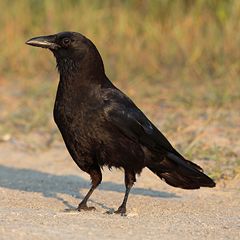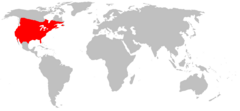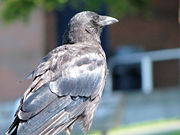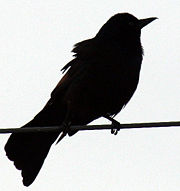American Crow
| American Crow | ||||||||||||||||||||||||
|---|---|---|---|---|---|---|---|---|---|---|---|---|---|---|---|---|---|---|---|---|---|---|---|---|
 |
||||||||||||||||||||||||
| Conservation status | ||||||||||||||||||||||||
|
Least Concern (IUCN 3.1) |
||||||||||||||||||||||||
| Scientific classification | ||||||||||||||||||||||||
|
||||||||||||||||||||||||
| Binomial name | ||||||||||||||||||||||||
| Corvus brachyrhynchos Brehm, 1822 |
||||||||||||||||||||||||
 Global range
|
The American Crow, Corvus brachyrhynchos, is a large passerine bird species of the family Corvidae. It is a common bird found throughout much of North America. In the interior of the continent south of the Arctic, it is simply "the crow" as no other such birds occur there on any regular basis.
It is one of several species of corvid which are entirely black in color, though it can be distinguished from the other two (but see also below) such birds in its range - from the Common Raven (C. corax) by size and behavior, and on the East Coast of the United States from the Fish Crow (C. ossifragus) by call.
American Crows are common, widespread and adaptable, but they are highly susceptible to the West Nile Virus. They are monitored as an indicator species. Direct transmission of the virus from American Crows to humans is not recorded to date and in any case not considered likely.
Contents |
Description
The American Crow is a distinctive bird with iridescent black feathers all over. Its legs, feet and bill are also black. They are 16-20 inches (about 40-50 cm) in length, of which the tail makes up about 40%. Each wing is around 7-8 in (27-34 cm) long. The bill length is on average 2 in (5 cm), varying strongly according to location.[1]
The most usual call is a loud, short, and rapid caah-caah-caah. Usually, the birds thrust their heads up and down as they utter this call. American Crows can also produce a wide variety of sounds and sometimes mimic noises made by other animals, including other birds.
Visual differentiation from the Fish Crow (C. ossifragus) is extremely difficult and often inaccurate. Nonetheless, differences apart from size do exist. Fish Crows tend to have more slender bills and feet. There may also be a small sharp hook at the end of the upper bill. Fish Crows also appear as if they have shorter legs when walking. More dramatically, when calling, Fish Crows tend to hunch and fluff their throat feathers.
If seen flying at a distance from where size estimates are unreliable, the distinctly larger Common Ravens (C. corax) can be distinguished by their almost lozenge-shaped tail, their larger-looking heads and of course their strongly solitary habits. They also fluff their throat feathers when calling like Fish Crows, only more so.[2]
Taxonomy and systematics

The American Crow was described by Christian Ludwig Brehm in 1822. Its scientific name means literally "short-billed crow", from Ancient Greek brachy- (βραχυ-) "short-" and rhynchos (ρυνχος) "bill".[3]
The Northwestern Crow (C. caurinus) is very closely related to the American Crow. Its ancestors became separated by Ice Age glaciation west of the Rocky Mountains. It is by and large endemic to Pacific temperate rain forests where it all but replaces the American Crow. Only in the Seattle region they co-coccur to any extent. In habitus, they are still much alike to each other from one another where their ranges overlap. The voice however represents a distinct difference between the two species.[4]
Four subspecies are recognized. They differ in bill proportion and form a rough NE-SW clinal in size across North America. Birds are smallest in the far west and on the south coast.[1]
- Corvus brachyrhynchos brachyrhynchos: Northeastern USA, eastern Canada and surroundings. Largest subspecies.
- Corvus brachyrhynchos hesperis – Western Crow: Western North America except arctic north, Pacific Northwest and extreme south. Smaller overall with a proportionally more slender bill[5] and low-pitched voice.
- Corvus brachyrhynchos pascuus – Florida Crow: Florida. Mid-sized, short-winged but decidedly long bill and legs.[5]
- Corvus brachyrhynchos paulus: Southern USA. Smaller overall, bill also small.[6]
Ecology
The range of the American Crow extends from the Pacific Ocean to the Atlantic Ocean in Canada, on the French islands of Saint-Pierre and Miquelon, south through the United States, and into northern Mexico.[7] Virtually all types of country from wilderness, farmland, parks, open woodland to towns and major cities are inhabited; it is absent only from Pacific temperate rain forests and tundra habitat. This crow is a permanent resident in most of the USA, but most Canadian birds migrate some distances southward in winter. Outside of the nesting season, these birds often gather in large communal roosts at night.
Most wild American Crows live for about 7-8 years. Captive birds are known to have lived up to 30 years.[8]
Food and feeding
The American Crow is omnivorous. It will feed on invertebrates of all types, carrion, scraps of human food, seeds, eggs and nestlings, stranded fish on the shore and various grains. American Crows are active hunters and will prey on mice, frogs, and other small animals. In winter and autumn, the diet of American Crows is more dependent on nuts and acorns. Occasionally, they will visit bird feeders.[9] The American Crow is one of only a few species of bird that has been observed modifying and using tools to obtain food.[10]
Like most crows, they will scavenge at rubbish dumps, scattering garbage in the process. Where available, corn, wheat and other crops are a favorite food. These habits have historically caused the American Crow to be considered a nuisance. However, it is suspected that the harm to crops is offset by the service the American Crow provides by eating insect pests.[9]

Nesting
American Crows are monogamous cooperative breeding birds. Mated pairs form large families of up to 15 individuals from several breeding seasons that remain together for many years.[11] Offspring from a previous nesting season will usually remain with the family to assist in rearing new nestlings. American Crows do not reach breeding age for at least two years.[12] Most do not leave the nest to breed for four to five years.[11]
The nesting season starts early, with some birds incubating eggs by early April already.[13] American Crows build bulky stick nests, nearly always in trees but sometimes also in large bushes and, very rarely, on the ground. They will nest in a wide variety of trees, including large conifers, although oaks are most often used. Three to six eggs are laid and incubated for 18 days. The young are usually fledged by about 35 days after hatching.
West Nile Virus
American Crows succumb easily to West Nile virus infection. This was originally a mosquito-borne African virus causing encephalitis in humans and livestock since about 1000 AD, and was accidentally introduced to North America in 1999, apparently by an infected air traveller who got bitten by a mosquito after arrival. It is estimated that the American Crow population has dropped by 45% since 1999; the disease runs most rampant in the subtropical conditions which encourage reproduction of its mosquito vectors among which Culex tarsalis is most significant. Mortality rates appear to be higher than those in other birds, causing local population losses of up to 72% in a single season.[14] Because of this, American Crows are a sentinel species indicating the presence of West Nile virus in an area. Crows cannot transmit the virus to humans directly.[8]
Status and conservation
American Crows are protected internationally by the Migratory Bird Treaty Act of 1918. Despite attempts by humans in some areas to drive away or eliminate these birds, they remain widespread and very common. The number of individual American Crows is estimated by Birdlife International to be around 31,000,000. The large population, as well as its vast range, are the reasons why the American Crow is considered to be of least concern, meaning that the species is not threatened.[7]
In popular culture
The abundance of the American Crow in both rural and urban environments have made them very familiar to all Americans. They are the archetypal "crow" of North America and have found their way to vernacular speech and popular culture.
- "Eating crow" means suffering embarrassment after having previously boasted. This phrase originates in the use of crows - including this species - as famine food (compare "humble pie"). While American Crows are theoretically edible they have little meat; in addition, namely those from densely-settled areas often carry parasites that can infect humans.
- In the early 20th century, "crow" was common as a racial slur for African-Americans. For example, the White American vaudeville act Moran and Mack had a performance called "Two Black Crows" which was popular in the 1920s, where they played two stereotyped "crows" speaking in exaggerated Black American accents.
- "Jim Crow" was originally the name of a 19th-century minstrel character. It became a collective term for blackface performances of that era, as well as laws - particularly in the American South - that segregated blacks.
Footnotes
- ↑ 1.0 1.1 Madge & Burn (1994)
- ↑ BirdWeb (2005)
- ↑ Liddell et al. (1980)
- ↑ Dick (2007)
- ↑ 5.0 5.1 Goodwin & Gillmor (1976): p.87
- ↑ Goodwin & Gillmor (1976): p.88
- ↑ 7.0 7.1 BLI (2004)
- ↑ 8.0 8.1 CDEP (2001)
- ↑ 9.0 9.1 Parr (2005)
- ↑ Caffrey (2000)
- ↑ 11.0 11.1 Roger Segelken: Tree-climbing researcher knows exactly how far the crow flies Cornell Chronicle. Retrieved 2006-OCT-25,
- ↑ CLO (2002), SAS (2005)
- ↑ Henninger (1906)
- ↑ CLO (2002), Caffrey et al. 2005)
References
- BirdLife International (BLI) (2004). Corvus brachyrhynchos. 2006 IUCN Red List of Threatened Species. IUCN 2006. Retrieved on 26 October 2006. Database entry includes justification for why this species is of least concern
- Caffrey, Carolee (2000): Tool Modification and Use by an American Crow]. Wilson Bull. 112(2): 283–284. DOI:10.1676/0043-5643(2000)112[0283:TMAUBA]2.0.CO;2 HTML abstract
- Caffrey, Carolee; Smith, Shauna C.R. & Weston, Tiffany J. (2005): West Nile Virus Devastates an American Crow Population. Condor 107(1): 128-132. doi:10.1650/7646 (HTML abstract)
- Cornell Lab of Ornithology (CLO) (2002): Bird Guide - American Crow. Retrieved 2006-OCT-24.
- Connecticut Department of Environmental Protection (CDEP) (2001): American Crow Fact Sheet. Version of 2001. Retrieved 2006-OCT-25.
- Dick, Gary Owen (2007): Whatbird.com Field Guide to Birds of North America - Retrieved 2007-OCT-18.
- Goodwin, Derek & Gillmor, Robert (1976): Crows of the World (1st ed.). University of Washington Press, Seattle.
- Henninger, W.F. (1906): A preliminary list of the birds of Seneca County, Ohio. Wilson Bull. 18(2): 47-60. DjVu fulltext PDF fulltext
- Liddell, Henry George; Scott, Robert; Stuart-Jones, Henry & McKenzie, Roderick: (1980): A Greek-English Lexicon (abridged ed.). Oxford University Press, Oxford, UK. ISBN 0-19-910207-4
- Madge, Steve & Burn, Hilary (1994): Crows and jays: a guide to the crows, jays and magpies of the world. A&C Black, London. ISBN 0-7136-3999-7
- Parr, C. (2005): Animal Diversity Web - Corvus brachyrhynchos. Retrieved 2007-OCT-24.
- Seattle Audubon Society (SAS): BirdWeb - American Crow. Retrieved 2006-OCT-24.
External links
Images
Video
- American Crow videos on the Internet Bird Collection